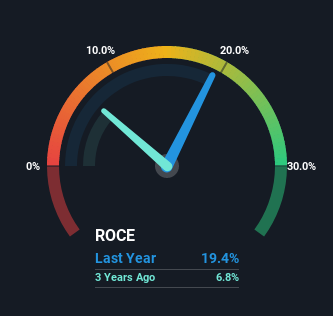- United States
- /
- General Merchandise and Department Stores
- /
- NasdaqGS:ETSY
We Like These Underlying Return On Capital Trends At Etsy (NASDAQ:ETSY)

If you're looking for a multi-bagger, there's a few things to keep an eye out for. Amongst other things, we'll want to see two things; firstly, a growing return on capital employed (ROCE) and secondly, an expansion in the company's amount of capital employed. Ultimately, this demonstrates that it's a business that is reinvesting profits at increasing rates of return. Speaking of which, we noticed some great changes in Etsy's (NASDAQ:ETSY) returns on capital, so let's have a look.
Understanding Return On Capital Employed (ROCE)
For those that aren't sure what ROCE is, it measures the amount of pre-tax profits a company can generate from the capital employed in its business. To calculate this metric for Etsy, this is the formula:
Return on Capital Employed = Earnings Before Interest and Tax (EBIT) ÷ (Total Assets - Current Liabilities)
0.19 = US$389m ÷ (US$2.6b - US$632m) (Based on the trailing twelve months to December 2022).
Therefore, Etsy has an ROCE of 19%. In absolute terms, that's a satisfactory return, but compared to the Multiline Retail industry average of 15% it's much better.
Check out our latest analysis for Etsy

In the above chart we have measured Etsy's prior ROCE against its prior performance, but the future is arguably more important. If you're interested, you can view the analysts predictions in our free report on analyst forecasts for the company.
So How Is Etsy's ROCE Trending?
Investors would be pleased with what's happening at Etsy. The data shows that returns on capital have increased substantially over the last five years to 19%. Basically the business is earning more per dollar of capital invested and in addition to that, 298% more capital is being employed now too. This can indicate that there's plenty of opportunities to invest capital internally and at ever higher rates, a combination that's common among multi-baggers.
In Conclusion...
A company that is growing its returns on capital and can consistently reinvest in itself is a highly sought after trait, and that's what Etsy has. And with the stock having performed exceptionally well over the last five years, these patterns are being accounted for by investors. With that being said, we still think the promising fundamentals mean the company deserves some further due diligence.
One final note, you should learn about the 3 warning signs we've spotted with Etsy (including 1 which doesn't sit too well with us) .
While Etsy isn't earning the highest return, check out this free list of companies that are earning high returns on equity with solid balance sheets.
Valuation is complex, but we're here to simplify it.
Discover if Etsy might be undervalued or overvalued with our detailed analysis, featuring fair value estimates, potential risks, dividends, insider trades, and its financial condition.
Access Free AnalysisHave feedback on this article? Concerned about the content? Get in touch with us directly. Alternatively, email editorial-team (at) simplywallst.com.
This article by Simply Wall St is general in nature. We provide commentary based on historical data and analyst forecasts only using an unbiased methodology and our articles are not intended to be financial advice. It does not constitute a recommendation to buy or sell any stock, and does not take account of your objectives, or your financial situation. We aim to bring you long-term focused analysis driven by fundamental data. Note that our analysis may not factor in the latest price-sensitive company announcements or qualitative material. Simply Wall St has no position in any stocks mentioned.
About NasdaqGS:ETSY
Etsy
Operates two-sided online marketplaces that connect buyers and sellers worldwide.
Slight with moderate growth potential.
Similar Companies
Market Insights
Community Narratives



